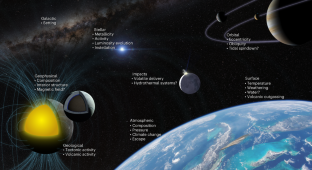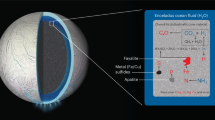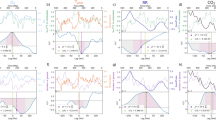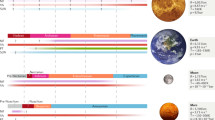Abstract
A major focus of the planetary science and astrobiology community is understanding planetary habitability, including the myriad factors that control the evolution and sustainability of temperate surface environments such as that of Earth. The few substantial terrestrial planetary atmospheres within the Solar System serve as a critical resource for studying these habitability factors, from which models can be constructed for application to extrasolar planets. The recent astronomy and astrophysics and planetary science and astrobiology decadal surveys both emphasize the need for an improved understanding of planetary habitability as an essential goal within the context of astrobiology. The divergence in climate evolution of Venus and Earth provides a major accessible basis for understanding how the habitability of large rocky worlds evolves with time and what conditions limit the boundaries of habitability. Here we argue that Venus can be considered an ‘anchor point’ for understanding planetary habitability within the context of the evolution of terrestrial planets. We discuss the major factors that have influenced the respective evolutionary pathways of Venus and Earth, how these factors might be weighted in their overall influence and the measurements that will shed further light on their impacts on these worlds’ histories. We further discuss the importance of Venus with respect to both the recent decadal surveys and how these community consensus reports can help shape the exploration of Venus in the coming decades.
This is a preview of subscription content, access via your institution
Access options
Access Nature and 54 other Nature Portfolio journals
Get Nature+, our best-value online-access subscription
$29.99 / 30 days
cancel any time
Subscribe to this journal
Receive 12 digital issues and online access to articles
$119.00 per year
only $9.92 per issue
Buy this article
- Purchase on Springer Link
- Instant access to full article PDF
Prices may be subject to local taxes which are calculated during checkout



Similar content being viewed by others
References
Borucki, W. J. KEPLER Mission: development and overview. Rep. Prog. Phys. 79, 036901 (2016).
Winn, J. & Fabrycky, D. C. The occurrence and architecture of exoplanetary systems. Annu. Rev. Astron. Astrophys. 53, 409 (2015).
Horner, J. et al. Solar System physics for exoplanet research. Publ. Astron. Soc. Pac. 132, 102001 (2020).
Kane, S. R. et al. The fundamental connections between the Solar System and exoplanetary science. J. Geophys. Res. Planets 126, e06643 (2021).
Kane, S. R. Atmospheric dynamics of a near tidally locked Earth-sized planet. Nat. Astron. 6, 420 (2022).
O’Rourke, J. G. et al. Venus, the planet: introduction to the evolution of Earth’s sister planet. Space Sci. Rev. 219, 10 (2023).
Smrekar, S. E., Davaille, A. & Sotin, C. Venus interior structure and dynamics. Space Sci. Rev. 214, 88 (2018).
Taylor, F. W., Svedham, H. & Head, J. W. Venus: the atmosphere, climate, surface, interior and near-space environment of an Earth-Like planet. Space Sci. Rev. 214, 35 (2018).
Goldblatt, C. & Watson, A. J. J. The runaway greenhouse: implications for future climate change, geoengineering and planetary atmospheres. Phil. Trans. R. Soc. A 370, 4197 (2012).
Goldblatt, C., Robinson, T. D., Zahnle, K. J. & Crisp, D. Low simulated radiation limit for runaway greenhouse climates. Nat. Geosci. 6, 661 (2013).
Ingersoll, A. P. The runaway greenhouse: a history of water on Venus. J. Atmos. Sci. 26, 1191 (1969).
Nakajima, S., Hayashi, Y.-Y. & Abe, Y. A study on the ‘runaway greenhouse effect’ with a one-dimensional radiative-convective equilibrium model. J. Atmos. Sci. 49, 2256 (1992).
Pathways to Discovery in Astronomy and Astrophysics for the 2020s (National Academies of Sciences, Engineering, and Medicine, 2023); https://doi.org/10.17226/26141
Origins, Worlds, and Life: A Decadal Strategy for Planetary Science and Astrobiology 2023–2032 (National Academies of Sciences, Engineering, and Medicine, 2023); https://doi.org/10.17226/26522
Benner, S. A. Defining life. Astrobiology 10, 1021 (2010).
Cleland, C. E. & Chyba, C. F. Defining ‘life’. Orig. Life Evol. Biosph. 32, 387 (2002).
Hill, M. L. et al. A catalog of habitable zone exoplanets. Astron. J. 165, 34 (2023).
Kane, S. R. et al. A catalog of Kepler habitable zone exoplanet candidates. Astrophys. J. 830, 1 (2016).
Kasting, J. F., Whitmire, D. P. & Reynolds, R. T. Habitable zones around main sequence stars. Icarus 101, 108 (1993).
Kopparapu, R. K. et al. Habitable zones around main-sequence stars: new estimates. Astrophys. J. 765, 131 (2013).
Kopparapu, R. K. et al. Habitable zones around main-sequence stars: dependence on planetary mass. Astrophys. J. Lett. 787, L29 (2014).
Brack, A. Liquid water and the origin of life. Orig. Life Evol. Biosph. 23, 3 (1993).
O’Rourke, J. G. et al. Detectability of remanent magnetism in the crust of Venus. Geophys. Res. Lett. 46, 5768 (2019).
Donahue, T. M. et al. Venus was wet: a measurement of the ratio of deuterium to hydrogen. Science 216, 630 (1982).
Elkins-Tanton, L. T. Linked magma ocean solidification and atmospheric growth for Earth and Mars. Earth Planet. Sci. Lett. 271, 181 (2008).
Lebrun, T. et al. Thermal evolution of an early magma ocean in interaction with the atmosphere. J. Geophys. Res. Planets 118, 1155 (2013).
Hamano, K., Abe, Y. & Genda, H. Emergence of two types of terrestrial planet on solidification of magma ocean. Nature 497, 607 (2013).
Way, M. J. et al. Was Venus the first habitable world of our solar system? Geophys. Res. Lett. 43, 8376 (2016).
Way, M. J. & Del Genio, A. D. Venusian habitable climate scenarios: modeling Venus through time and applications to slowly rotating Venus-like exoplanets. J. Geophys. Res. Planets 125, e06276 (2020).
Krissansen-Totton, J. et al. Was Venus ever habitable? Constraints from a coupled interior–atmosphere–redox evolution model. Planet. Sci. J. 2, 216 (2021).
Luger, R. & Barnes, R. Extreme water loss and abiotic O2 buildup on planets throughout the habitable zones of M dwarfs. Astrobiology 15, 119 (2015).
Kane, S. R., Kopparapu, R. K. & Domagal-Goldman, S. D. On the frequency of potential Venus analogs from Kepler data. Astrophys. J. Lett. 794, L5 (2014).
Gillmann, C., Chassefière, E. & Lognonné, P. A consistent picture of early hydrodynamic escape of Venus atmosphere explaining present Ne and Ar isotopic ratios and low oxygen atmospheric content. Earth Planet. Sci. Lett. 286, 503 (2009).
Kane, S. R. et al. Venus as a laboratory for exoplanetary science. J. Geophys. Res. Planets 124, 2015 (2019).
Byrne, P. K. & Krishnamoorthy, S. Estimates on the frequency of volcanic eruptions on Venus. J. Geophys. Res. 127, e2021JE007040 (2022).
Driscoll, P. E. in Handbook of Exoplanets (eds Deeg, H. & Belmonte, J.) 2917–2935 (Springer, 2018).
Walker, J. C. G. et al. A negative feedback mechanism for the long-term stabilization of Earth’s surface temperature. J. Geophys. Res. Oceans 86, 9776 (1981).
Davaille, A. et al. Experimental and observational evidence for plume-induced subduction on Venus. Nat. Geosci. 10, 349 (2017).
Tikoo, S. M. & Elkins-Tanton, L. T. The fate of water within Earth and super-Earths and implications for plate tectonics. Phil. Trans. R. Soc. A 375, 20150394 (2017).
Barsukov, V. L. et al. The geology and geomorphology of the Venus surface as revealed by the radar images obtained by Veneras 15 and 16. J. Geophys. Res. Solid Earth 91, 378 (1986).
Hashimoto, G. L. et al. Felsic highland crust on Venus suggested by Galileo near-infrared mapping spectrometer data. J. Geophys. Res. Planets 113, E00B24 (2008).
Romeo, I. & Turcotte, D. L. Pulsating continents on Venus: an explanation for crustal plateaus and tessera terrains. Earth Planet. Sci. Lett. 276, 85 (2008).
Campbell, I. H. & Taylor, S. R. No water, no granites—no oceans, no continents. Geophys. Res. Lett. 10, 1061 (1983).
Ostberg, C. et al. The demographics of terrestrial planets in the Venus zone. Astron. J. 165, 168 (2023).
Borucki, W. J. et al. Kepler planet-detection mission: introduction and first results. Science 327, 977 (2010).
Ricker, G. R. et al. Transiting Exoplanet Survey Satellite (TESS). J. Astron. Telesc. Instrum. Syst. 1, 014003 (2015).
Bryson, S. et al. The occurrence of rocky habitable-zone planets around solar-like stars from Kepler data. Astron. J. 161, 36 (2021).
Dressing, C. D. & Charbonneau, D. The occurrence rate of small planets around small stars. Astrophys. J. 767, 95 (2013).
Kopparapu, R. K. A revised estimate of the occurrence rate of terrestrial planets in the habitable zones around Kepler M-dwarfs. Astrophys. J. Lett. 767, L8 (2013).
Kane, S. R. & von Braun, K. Constraining orbital parameters through planetary transit monitoring. Astrophys. J. 689, 492 (2008).
Foley, B. J. The role of plate tectonic-climate coupling and exposed land area in the development of habitable climates on rocky planets. Astrophys. J. 812, 36 (2015).
Ostberg, C. & Kane, S. R. Predicting the yield of potential Venus analogs from TESS and their potential for atmospheric characterization. Astron. J. 158, 195 (2019).
Barstow, J. K. et al. Telling twins apart: exo-Earths and Venuses with transit spectroscopy. Mon. Not. R. Astron. Soc. 458, 2657 (2016).
Ehrenreich, D. et al. Transmission spectrum of Venus as a transiting exoplanet. Astron. Astrophys. 537, L2 (2012).
Schwieterman, E. W. et al. Exoplanet biosignatures: a review of remotely detectable signs of life. Astrobiology 18, 663 (2018).
Cowan, N. B. & Strait, T. E. Determining reflectance spectra of surfaces and clouds on exoplanets. Astrophys. J. Lett. 765, L17 (2013).
Madhusudhan, N. Exoplanetary atmospheres: key insights, challenges, and prospects. Annu. Rev. Astron. Astrophys. 57, 617 (2019).
Arney, G. et al. Spatially resolved measurements of H2O, HCl, CO, OCS, SO2, cloud opacity, and acid concentration in the Venus near-infrared spectral windows. J. Geophys. Res. Planets 119, 1860 (2014).
Bezard, B., de Bergh, C., Crisp, D. & Mallard, J.-P. The deep atmosphere of Venus revealed by high-resolution nightside spectra. Nature 345, 508 (1990).
Cascioli, G. et al. The determination of the rotational state and interior structure of Venus with VERITAS. Planet. Sci. J. 2, 220 (2021).
Garvin, J. B. et al. Revealing the mysteries of Venus: the DAVINCI mission. Planet. Sci. J. 3, 117 (2022).
Widemann, T. et al. Venus evolution through time: key science questions, selected mission concepts and future investigations. Space Sci. Rev. 219, 56 (2023).
Dziewonski, A. M. & Anderson, D. L. Preliminary reference Earth model. Phys. Earth Planet. Int. 25, 297–356 (1981).
James, P. B., Zuber, M. T. & Phillips, R. J. Crustal thickness and support of topography on Venus. J. Geophys. Res. Planets 118, 859–875 (2013).
Aitta, A. Venus’ internal structure temperature and core composition. ICARUS 218, 967–974 (2012).
Acknowledgements
S.R.K. acknowledges support from NASA grant number 80NSSC21K1797, funded through the NASA Habitable Worlds Program. The results reported herein benefited from collaborations and/or information exchange under NASA’s Nexus for Exoplanet System Science (NexSS) research coordination network, which is sponsored by NASA’s Science Mission Directorate. P.K.B. acknowledges support from Washington University in St. Louis. This research made use of NASA’s Astrophysics Data System.
Author information
Authors and Affiliations
Contributions
S.R.K. and P.K.B. conceived the idea of this Perspective. S.R.K. led the writing and the production of the figures, and P.K.B. contributed to the writing and the production of the figures.
Corresponding author
Ethics declarations
Competing interests
The authors declare no competing interests.
Peer review
Peer review information
Nature Astronomy thanks Elizabeth Tasker and Daniel Nunes for their contribution to the peer review of this work.
Additional information
Publisher’s note Springer Nature remains neutral with regard to jurisdictional claims in published maps and institutional affiliations.
Rights and permissions
Springer Nature or its licensor (e.g. a society or other partner) holds exclusive rights to this article under a publishing agreement with the author(s) or other rightsholder(s); author self-archiving of the accepted manuscript version of this article is solely governed by the terms of such publishing agreement and applicable law.
About this article
Cite this article
Kane, S.R., Byrne, P.K. Venus as an anchor point for planetary habitability. Nat Astron 8, 417–424 (2024). https://doi.org/10.1038/s41550-024-02228-5
Received:
Accepted:
Published:
Issue Date:
DOI: https://doi.org/10.1038/s41550-024-02228-5



